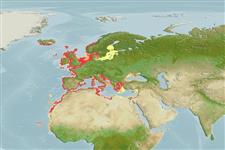分类 / Names
俗名 | 同种异名 | Catalog of Fishes(属, 种) | ITIS | CoL | WoRMS | Cloffa
Environment: milieu / climate zone / depth range / distribution range
生态学
海洋; 淡水; 半咸淡水 居于水底的; 降海洄游 (Ref. 46888); 深度上下限 2 - 15 m (Ref. 130217). ; 65°N - 12°N, 24°W - 36°E
Eastern Atlantic: Scandinavia and Iceland (Ref. 4537) south to Senegal and Cape Verde. Also Mediterranean Sea; southwestern Black Sea (Ref. 2058).
Length at first maturity / 大小 / 重量 / 年龄
Maturity: Lm 29.5 range ? - ? cm
Max length : 75.0 cm SL 雄鱼/尚未辨别雌雄; (Ref. 35388); common length : 32.0 cm SL 雄鱼/尚未辨别雌雄; (Ref. 7399); 最大体重: 4.5 kg (Ref. 35388); 最大年龄: 25 年 (Ref. 35388)
背棘 (总数) : 5; 背的软条 (总数) : 7 - 9; 臀棘: 3; 臀鳍软条: 8 - 9.
Adults are found inshore in schools, frequently entering brackish lagoons and freshwater (Ref. 30578). They migrate occasionally tending to move northward in summer-time as temperatures rise. Females are larger than males (Ref. 59043). Adults feed mainly on benthic diatoms, epiphytic algae, small invertebrates and detritus (Ref. 2804), juveniles only feed on zooplankton (Ref. 59043). Oviparous (Ref. 205). Reproduction occurs in the sea during winter (Ref. 30578). Eggs and larvae pelagic. Utilized as a food fish (Ref. 4645).
Juveniles around 2.0 cm SL move to coastal lagoons and estuaries in April-June and return to sea in summer (Ref. 59043).
Thomson, J.M., 1986. Mugilidae. p. 344-349. In J. Daget, J.-P. Gosse and D.F.E. Thys van den Audenaerde (eds.) Check-list of the freshwater fishes of Africa (CLOFFA). ISNB, Brussels, MRAC; Tervuren; and ORSTOM, Paris. Vol. 2. (Ref. 3573)
人类利用
渔业: 商业性; 游钓鱼种: 是的; 水族馆: 公众的水族馆
工具
特别资料
下载 XML
网络资源
Estimates based on models
Preferred temperature (Ref.
123201): 8.8 - 20.1, mean 11 °C (based on 420 cells).
Phylogenetic diversity index (Ref.
82804): PD
50 = 0.5005 [Uniqueness, from 0.5 = low to 2.0 = high].
Bayesian length-weight: a=0.00724 (0.00559 - 0.00939), b=3.11 (3.03 - 3.19), in cm total length, based on LWR estimates for this species (Ref.
93245).
营养阶层 (Ref.
69278): 2.6 ±0.32 se; based on food items.
回复力 (Ref.
120179): 中等的, 族群倍增时间最少 1.4 - 4.4年 (K=0.12-0.17; tm=3; tmax=25).
Fishing Vulnerability (Ref.
59153): High vulnerability (63 of 100).
Climate Vulnerability (Ref.
125649): Moderate to high vulnerability (51 of 100).
Nutrients (Ref.
124155): Calcium = 39.2 [10.7, 335.3] mg/100g; Iron = 0.623 [0.303, 1.151] mg/100g; Protein = 17.9 [16.5, 19.5] %; Omega3 = 0.399 [0.166, 0.964] g/100g; Selenium = 9.58 [3.60, 24.88] μg/100g; VitaminA = 7.52 [2.12, 24.93] μg/100g; Zinc = 0.571 [0.342, 0.951] mg/100g (wet weight); based on
nutrient studies.
